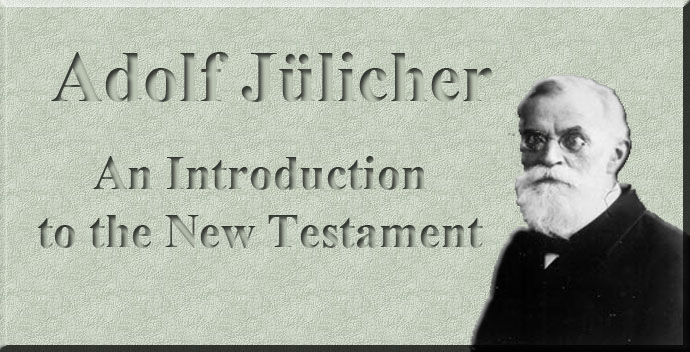
An Introduction to the New Testament
By Adolf Jülicher
PART TWO
Chapter 3 - Section 44
|
§ 44. The Final Settlement of the New Testament in the national Churches of the East When the rich remains of Syrian literature shall have been thoroughly examined and made universally accessible, a continuous history of the New Testament among the Syrians (on whom the other national Churches of the Hast, the Persian and the Armenian, are dependent) may probably be written, from the earliest times down to our own day. Until that time we must content ourselves with indicating the few perfectly certain points. Through Cosmas1 we know that there were only three Catholic Epistles in the Syrian Canon, James, 1. Peter and 1. John; this agrees with the state of the case in the Syrian translation of the Bible, the Peshitto. In its present state this document cannot be older than the fourth century; thus the only certain inference it affords is that the Syrian Church of the fourth century possessed a New Testament of twenty-two books—Jude, 2. Peter, 2. and 3. John and the Apocalypse being absent. We do not know when the Syrians gave up the pseudo-Corinthian correspondence; it can scarcely have been before—the fifth century. The breath of criticism from Antioch swept away the Apocrypha: to the same cause may be ascribed the resistance offered in Syria to an enlargement of the New Testament by the addition of the Apocalypse (which was certainly known to Ephraim) and the four minor Catholic Epistles. Even James is again somewhat thrust into the shade; at least in the great School of Nisibis, according to Junilius,2 after the Epistles of Paul, only 1. Peter and 1. John are recognised as absolutely authoritative books, while the other five—and still more the Apocalypse, ʽwhich is considered very doubtful by the Orientalsʼ—enjoy but a secondary rank. Probably it seemed enough at Nisibis that theologians should be acquainted with such debated writings; the laity were offered only those which possessed the highest authority. Since the East Syrian Church subscribed to Nestorianism (condemned from the time of the Council of Ephesus in 481) and was thus entirely cut off from the neighbouring Western Churches, we can scarcely imagine any motive which could induce it to complete its New Testament after the pattern of the Greek; we cannot be surprised that a Syrian manuscript (probably Hast Syrian) of the year 1470, formally concludes its New Testament with the Pauline Epistles, and then proceeds: ʽWe here add to the Epistles of Paul the Epistles of the Apostles which are not to be found in all the Codices.ʼ Then follow 2. Peter, 2. and 3. John, Jude, and the two ʽClementineʼ Epistles on Virginity. In West Syria Monophysitism prevailed. The Syrian Monophysites kept up a lively correspondence with those of like mind among the Greeks and Copts; the respect for the authority of Greek tradition, which led them about 500 to undertake a more accurate translation of the original text than the)Peshitto, was also the occasion of their increasing their three Catholic Epistles to seven, in accordance with the Greek MSS. But even the second and revised edition of that translation (that of 616), which is better known to us, did not, apparently, originally include the Apocalypse, which was added later, and at last found its way into the Peshitto manuscripts together with the four minor Catholic Epistles. The Monophysite Dionysius Bar Salibi († 1171) wrote commentaries on the Apocalypse, the Acts, seven Catholic and fourteen Pauline Epistles, in exactly the same style as on the four Gospels. The anti-Chalcedonian Armenians imitated their Syrian brethren; but the anxiety of the Westerns as to the separation of the Canonical from other early Christian literature is not to befound among any Orientals. As the Armenians were edified by 3. Corinthians, soa certain Syrian Bible-Codex written at Edessa in 1170 placed the Epistles of Clement of Rome (but not the ʽDe Virginitateʼ) between Jude and Romans as Canonical books, and even provided them with a system of pericopic subdivision!
|
|
 |
 |
|
1) See p. 547. 2) See p. 9.
|
|
-
Site Navigation
 Home
Home What's New
What's New Bible
Bible Photos
Photos Hiking
Hiking E-Books
E-Books Genealogy
Genealogy Profile
Free Plug-ins You May Need
Profile
Free Plug-ins You May Need
 Get
Java
Get
Java.png) Get Flash
Get Flash Get
7-Zip
Get
7-Zip Get Acrobat Reader
Get Acrobat Reader Get
TheWORD
Get
TheWORD